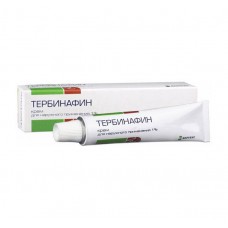Expiration date: 08/2026
Cream
Composition
1 g contains: terbinafine hydrochloride 10 mg
Packaging
Tube 15 or 30g
pharmachologic effect
Terbinafine - antifungal agent is an allylamine, which has a broad spectrum of activity against fungi which cause diseases of the skin, hair and nails, including dermatophytes such as Trichophyton (eg T.rubrum, T.mentagrophytes, T.tonsurans, T .verrucosum, T.violaceum), Microsporum (eg, .M. Canis), Epidermophyton floccosum, fungi and yeast genus Candida (e.g., Candida albicans) and Pityrosporum. At low concentrations of terbinafine has fungicidal activity against dermatophytes, molds and certain dimorphic fungi. Activity against yeast fungi, depending on their type, may be a fungicidal or fungistatic.
Terbinafine specifically inhibits the early stage of the biosynthesis of sterols in fungal cells. This leads to a deficiency of ergosterol and intracellular accumulation of squalene, which causes death of fungal cells. Terbinafine action effected by inhibition of the enzyme squalene epoxidase in the cell membrane of the fungus. This enzyme does not belong to the cytochrome P450 system. Terbinafine has no influence on the metabolism of hormones or other drugs.
Testimony
Fungal skin caused by dermatophytes, candidiasis, pityriasis versicolor.
Contraindications
Hypersensitivity to the drug, pregnancy and lactation.
Dosing and Administration
External used 1-2 times in 1-2 weeks.
Side effects
From the digestive system: nausea, anorexia, mild abdominal pain, diarrhea, disorders or loss of taste, cholestasis, jaundice, hepatitis.
Allergic reactions: skin rash, rarely - arthralgia, myalgia, erythema multiforme, Stevens-Johnson syndrome.
CNS: headache.
Co Hematopoietic system: neutropenia, thrombocytopenia.
Local reactions: redness, itching, burning sensation.
Special instructions
Irregular use of terbinafine or premature discontinuation of treatment may lead to recurrence of the disease. If after 2 weeks of treatment of skin infection is not marked improvement, it is necessary to re-determine the causative agent and its sensitivity to the drug. Systemic application in onychomycosis is justified only in case of defeat, most nails, availability pronounced subungual hyperkeratosis, ineffectiveness of previous local therapy. In the treatment of onychomycosis clinical response, laboratory confirmed, usually occurs several months after mycological cure and treatment discontinuation rate due to the rate of regrowth of healthy nail. Removal of the nail plate in the treatment of onychomycosis of brushes for 3 weeks and onychomycosis stop for 6 weeks is required.
In the presence of liver disease may be the clearance of terbinafine is reduced. During treatment necessary to control indicators of activity of "liver" transaminases in blood serum.
In rare cases, after 3 months of treatment there is cholestasis and hepatitis. When liver function disorders symptoms (fatigue, persistent nausea, loss of appetite, excessive abdominal pain, jaundice, dark urine or discolored feces) drug should be discontinued.
Appointment of terbinafine psoriasis patients requires caution, because very rarely terbinafine can cause exacerbation of psoriasis. In the treatment of terbinafine should comply with the general rules of hygiene to prevent the possibility of re-infection through underwear and shoes. During the treatment (2 weeks) and at the end it is necessary to produce the antifungal treatment of footwear, socks and stockings.
Drug interactions
Drugs associated with the induction of hepatic microsomal enzymes, increase the clearance of terbinafine, drugs that inhibit hepatic microsomal enzymes - reduce clearance of terbinafine.
Storage conditions
Store at temperatures not above 25 ° C.
Tablets
Composition
1 tablet contains:
Active ingredient: 250 mg terbinafine hydrochloride,
Excipients: microcrystalline cellulose, giproloza (hydroxypropyl cellulose), croscarmellose sodium, colloidal silicon dioxide, calcium stearate, lactose monohydrate
Packaging
10 tablets.
10 pieces
Pharmachologic effect
Terbinafine - antifungal agent. It has a broad spectrum of activity against fungi which cause diseases of the skin, hair and nails, including:
dermatophytes such as Trichophyton (eg, T. rubrum, T. mentagrophytes, T. verrucosum, T. tonsurans, T. violaceum), Microsporum (eg, M. canis), Epidermophyton floccosum,
yeast genus Candida (e.g., C. albicans) and Pityrosporum.
At low concentrations of terbinafine has fungicidal activity against dermatophytes, molds and certain dimorphic fungi. Activity against yeast fungi, depending on their type, may be a fungicidal or fungistatic.
The mechanism of action is associated with a specific suppression of the early stage of the biosynthesis of sterols in fungal cells. This leads to a deficiency of ergosterol and to an intracellular accumulation of squalene, which causes death of fungal cells. Terbinafine action effected by inhibition of the enzyme squalene epoxidase in the cell membrane of the fungus. This enzyme does not belong to the cytochrome P450 system. Terbinafine has no significant effect on the metabolism of hormones or other drugs.
Pharmacokinetics
When assigning terbinafine into the skin, hair and nails are drug concentration providing fungicidal activity.
After receiving a single oral dose of terbinafine 250 mg its maximum concentration achieved after 2 hours and the plasma was 0.97 micrograms / ml. poluabsorbtsii period of 0.8 hours, and the period poluraspredeleniya - 4.6 hours. Although terbinafine bioavailability moderately altered by food, but not to such an extent that the correction required dose.
Terbinafine largely bound to plasma proteins (99%). It quickly penetrates the dermal layer of the skin, and concentrates in the lipophilic stratum corneum. Terbinafine is also penetrates the sebum, which results in a high concentration in the hair follicles, the hair and the skin rich in sebaceous glands. We also show that terbinafine penetrates the nail plate in the first few weeks after beginning therapy.
Terbinafine is metabolised rapidly and substantially, with the participation of at least seven isoenzymes of cytochrome P450, with the main role is played isoenzymes CYP2C9, CYP1A2, CYP3A4, CYP2C8 and CYP2C19. The resulting biotransformation terbinafine metabolites formed without having antifungal activity and can be output primarily with urine. The final half-life of 17 hours. Any evidence of drug accumulation in the body is not there. There were no changes in the equilibrium concentration of terbinafine in the plasma depends on the age, but in patients with impaired renal or hepatic function may be delayed excretion rate of the drug, resulting in higher concentrations of terbinafine blood.
The local application or spray cream is absorbed less than 5% of the dose is thus minimal systemic exposure to the drug.
Testimony
Fungal infections of the scalp (trihofitia, mikrosporiya).
Fungal diseases of the skin and nails (onychomycosis), due Trychophyton (T. rubrum, T. mentagrophytes, T. verrucosum, T. violaccum), Microsporum (M. sanis, M. gypseum) and Epidermophyton floccosum.
Heavy, common ringworm smooth skin of the trunk and limbs requiring systemic treatment.
Candidiasis of skin and mucous membranes.
Contraindications
Hypersensitivity expressed hepatocellular and renal failure, blood disorders, cancer, metabolic diseases, pathology limbs, pregnancy, lactation, children's age (up to 2 years).
Pregnancy and breast-feeding
It was not teratogenic in experimental studies of the properties of terbinafine found.
Use of the drug during pregnancy is possible in cases where the expected benefit to the mother outweighs the potential risk to the fetus. Terbinafine is excreted in breast milk. If necessary, use during lactation should decide the issue of termination of breastfeeding.
Dosing and Administration
The duration of treatment depends on the indication and the severity of the disease.
Children: Inside, after eating, appoint one times a day. Single dose depends on the body weight and is: for children weighing less than 20 kg - 62.5 mg (half tablets of 125 mg), 20 to 40 kg - 125 mg (one 125 mg tablet), 40 kg - 250 mg (two 125 mg tablets).
Adults: 250 mg once daily in the evening or 2 times daily 125 mg.
Infections of the skin:
The recommended duration of treatment:
tinea pedis (interdigital, plantar or socks type): 2-6 weeks
ringworm of the trunk, limbs, legs: 2-4 weeks
Skin candidiasis: 2-4 weeks.
Complete disappearance of the manifestations of infection and complaints associated with it, can come only a few weeks after mycological cure.
Infections hair and scalp:
The recommended duration of treatment:
fungal infection of the scalp: 4 weeks.
Fungal infections of the scalp mostly seen in children.
Onychomycosis:
Duration of treatment is effective in most patients, from 6 to 12 weeks. In onychomycosis brushes in most cases enough to 6 weeks of treatment. In onychomycosis stop in most cases enough to 12 weeks of treatment. Some patients who have a decreased rate of nail growth, may require longer treatment. The optimal clinical effect is seen some months after mycological cure and cessation of therapy. This is determined by the period of time that is required for regrowth of healthy nail.
The use of terbinafine in the elderly:
There is no reason to assume that the elderly need to change the dosing of the drug, or that they have marked side effects that differ from those of younger patients. In the case of use in this age group of the drug in tablets should consider the possibility of concomitant abnormal liver or renal function.
Side effects
Heaviness and pain in the epigastric region, taste disturbance, loss of appetite, nausea, diarrhea, cholestasis, neutropenia, thrombocytopenia, allergic skin reaction, burning sensation, redness and itching in the area of ??application of the cream.
Special instructions
Suggestive of liver dysfunction such as unexplained persistent nausea, vomiting, lack of appetite, fatigue, jaundice, pain in the right upper quadrant, dark urine or discolored feces, in this case, you should confirm the hepatic origin of these symptoms If in the course of terbinafine in a patient observed phenomena (determination of serum concentrations of ALT, ACT) and cancel terbinafine. Patients should be warned of the need to consult a doctor in case of symptoms like him.
Patients with impaired renal function (creatinine clearance less than 50 mL / min or serum creatinine of more than 300 mmol / l) should receive half the normal dose.
Drug interactions
Inhibits isozyme CYP2P6 and inhibits metabolism of drugs such as tricyclic antidepressants and selective serotonin reuptake inhibitor (e.g., desipramine, fluvoxamine), beta-blockers (metoprolol, propranolol), antiarrhythmics (flecainide, propafenone), monoamine oxidase inhibitors in type (for example, selegiline) and antipsychotics (e.g., chlorpromazine, haloperidol) means.
Medications - inducers of cytochrome P450 isoenzymes (eg, rifampin) may accelerate the excretion of terbinafine from the body.
Drugs - inhibitors of cytochrome P450 isoenzymes (eg, cimetidine) may slow the metabolism and excretion of terbinafine from the body. With the simultaneous use of these drugs may require dose adjustment of terbinafine.
Possible disruption of the menstrual cycle while taking terbinafine and oral contraceptives.
Terbinafine decreases the clearance of caffeine by 21% and prolongs its half-life by 31%. It does not affect the clearance of phenazone, digoxin, warfarin.
When combined with ethanol or drugs having gepatoksicheskim action, there is the risk of liver disease drug.
Overdose
Symptoms: headache, dizziness, nausea, vomiting, epigastric pain, frequent urination, rash.
Treatment: removal of preparation for the event (gastric lavage, administration of activated charcoal), if necessary - symptomatic supportive therapy.
Storage conditions
In a dry place at a temperature no higher than 25 ° C
Shelf life
3 years.



